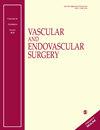Pulmonary Artery Endograft Implantation Using a Parallel Stent Grafting Technique to Enable the Treatment of a Bronchial Anastomosis Complication After Lung Transplantation
IF 0.7
4区 医学
Q4 PERIPHERAL VASCULAR DISEASE
引用次数: 0
Abstract
BackgroundBronchial stenosis associated with bronchial anastomosis dehiscence after lung transplantation is a catastrophic complication following lung transplantation with a paucity of therapeutic solutions.PurposeTo describe an adaptation of the parallel stent grafting technique in the pulmonary arterial territory to treat this challenging situation.Research DesignThis is a case report of a 52-year-old patient who presented bronchus stenosis and bronchial anastomosis dehiscence after lung transplantion. Bronchial stenting and lung retransplantation were contraindicated. Therefore, an endovascular approach using pulmonary artery endograft placement to prevent bleeding during repeated right bronchial balloon dilation was propposed. The technique consists of the deployment of an aortic extender endoprosthesis in the right main pulmonary artery and a balloon expandable stent in the upper lobe pulmonary artery (using a parallel graft configuration) through the common femoral and right internal jugular veins, respectively. Intraoperative transesophageal echocardiogram and one-lung ventilatory ventilation are needed.ResultsThe patient underwent a new bronchoscopy 16 days after the procedure, that showed epithelization at the previous eroded zone, enabling bronchocopic balloon dialtion to be safely performed. A post-operative contrast-enhanced CT scan revealed an adequate positioning of the stent grafts. Despite all eforts, the patient succumbed to ventilator associated pneumonia on postoperative day 108.Data AnalysisThe technique's advantages include its feasibility even in situations in which other techniques may be contraindicated and its potential use in emergencies. Its limitations include the need for experienced interventionists to perform it, and the potential risk of acute tricuspid regurgitation.ConclusionThis study illustrates the early feasibility of the parallel stent grafting technique applied to the pulmonary artery territory. However, it's safety profile regarding infectious risk was not demontrated.利用平行支架移植技术进行肺动脉内膜移植以治疗肺移植术后支气管吻合术并发症
背景肺移植术后支气管狭窄伴支气管吻合口开裂是肺移植术后的一种灾难性并发症,目前尚无治疗方法。目的描述在肺动脉区域采用平行支架移植技术来治疗这种具有挑战性的情况。支气管支架植入术和肺再移植术都是禁忌症。因此,为了防止在反复右支气管球囊扩张过程中出血,建议采用肺动脉内膜移植的血管内方法。该技术包括通过股总静脉和右颈内静脉分别在右主肺动脉中植入主动脉扩展器内支架和在上叶肺动脉中植入球囊可扩张支架(使用平行移植物配置)。术中需要进行经食道超声心动图检查和单肺通气。结果患者在术后16天接受了新的支气管镜检查,结果显示之前的侵蚀区出现了上皮化,从而可以安全地进行支气管镜下球囊扩张术。术后造影剂增强 CT 扫描显示支架移植物位置适当。尽管做了各种努力,患者还是在术后第 108 天死于呼吸机相关性肺炎。数据分析该技术的优点包括即使在其他技术可能禁忌的情况下也具有可行性,以及在紧急情况下的潜在用途。其局限性包括需要经验丰富的介入专家来操作,以及急性三尖瓣反流的潜在风险。然而,该技术在感染风险方面的安全性尚未得到证实。
本文章由计算机程序翻译,如有差异,请以英文原文为准。
求助全文
约1分钟内获得全文
求助全文
来源期刊

Vascular and Endovascular Surgery
SURGERY-PERIPHERAL VASCULAR DISEASE
CiteScore
1.70
自引率
11.10%
发文量
132
审稿时长
4-8 weeks
期刊介绍:
Vascular and Endovascular Surgery (VES) is a peer-reviewed journal that publishes information to guide vascular specialists in endovascular, surgical, and medical treatment of vascular disease. VES contains original scientific articles on vascular intervention, including new endovascular therapies for peripheral artery, aneurysm, carotid, and venous conditions. This journal is a member of the Committee on Publication Ethics (COPE).
 求助内容:
求助内容: 应助结果提醒方式:
应助结果提醒方式:


